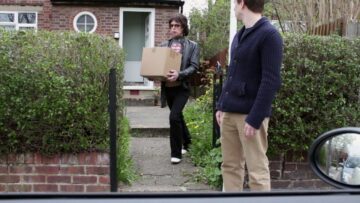[Most Recent Entries] [Calendar View]
Tuesday, December 28th, 2021
| Time | Event |
| 8:38a | The Jagger Moving Company  
The Jagger Moving Company is a post from: Open Culture. Follow us on Facebook and Twitter, or get our Daily Email. And don't miss our big collections of Free Online Courses, Free Online Movies, Free eBooks, Free Audio Books, Free Foreign Language Lessons, and MOOCs. |
| 12:00p | The Omicron Variant Explained by Neil deGrasse Tyson & Regeneron President George Yancopoulos What is the Omicron Variant? How do vaccines work? And what about monoclonal antibody therapy? On this episode of StarTalk, Neil deGrasse Tyson has a wide-ranging and quite informative conversation with George Yancopoulos, president of Regeneron, the company that created the monoclonal antibody therapy now being used in the fight against COVID-19. And there’s an interesting side note: During the 1970s, Tyson and Yancopoulos were high school classmates together at Bronx Science. They’ve both come a long way, and now they re-unite to explain the science behind the latest phase of the pandemic. Would you like to support the mission of Open Culture? Please consider making a donation to our site. It’s hard to rely 100% on ads, and your contributions will help us continue providing the best free cultural and educational materials to learners everywhere. You can contribute through PayPal, Patreon, Venmo (@openculture) and Crypto. Thanks! Related Content 1,700 Free Online Courses from Top Universities. Neil deGrasse Tyson Lists 8 (Free) Books Every Intelligent Person Should Read MIT Presents a Free Course on the COVID-19 Pandemic The Omicron Variant Explained by Neil deGrasse Tyson & Regeneron President George Yancopoulos is a post from: Open Culture. Follow us on Facebook and Twitter, or get our Daily Email. And don't miss our big collections of Free Online Courses, Free Online Movies, Free eBooks, Free Audio Books, Free Foreign Language Lessons, and MOOCs. |
| 3:00p | Why Europe Has So Few Skyscrapers Guy de Maupassant ate lunch at the restaurant in the base of the Eiffel Tower nearly every day, that being the only place in Paris where he wouldn’t have to look at the Eiffel Tower. 130 years later, the observation deck of the Tour Montparnasse is known to offer the most beautiful vista on the French capital — thanks precisely to the invisibility of the Tour Montparnasse. Spare a thought, if you will, for that highly conspicuous building, quite possibly the loneliest in Europe. Since its completion in 1973, it has stood as the sole skyscraper in Paris proper, its famous unsightliness having inspired a ban on the construction of buildings over seven stories high in the city center. Paris isn’t alone in its lack of skyscrapers, a condition travelers from Asia and America notice in cities all over the Continent. In the video above, construction-themed Youtube channel The B1M explores the reasons for this relative paucity of tall towers in the capitals of Europe. “When skyscrapers first rose to prominence in the 19th century, first in Chicago and later in New York, many European cities were already firmly established with grand historic buildings and public spaces that left little room for large new structures,” says its narrator. At that time, a growing sense of cultural competition between America and Europe also meant that “each continent became wary of adopting the other’s concepts.” Then came the Second World War, in the wake of whose devastation of Europe “an overwhelming desire to restore what had been destroyed took hold.” Few Continental cities held off the kind of demand for floor space that drove skyscraper construction in America. In the east, the Soviets built mostly “mid-rise, repetitive structures that sought to rehouse much of the population”; in the west, the restrictive phenomenon of “Brusselization” took hold in response to a wave of bulky postwar-modernist structures “that had little regard for architectural or cultural value.” This led to “a general dislike for modern buildings across Europe, with many seeing them as bland or soulless.” No one who’s spent time in American city centers built up predominantly in the 1960s and 70s can dismiss those European detractors’ fears. But it would be a lie to claim that European cities have avoided skyscrapers entirely: even Paris has simply pushed them a few miles away, into unromantic business districts like La Défense. Ever-taller buildings have symbolized modernity for well over a century now, and no civilization can afford to keep modernity at too great a distance. Taking note of how attitudes toward skyscrapers have been “softening across the Continent” in the 21st century, this B1M video speculates on the possibility of a “skyscraper boom” in Europe. But even if that should happen, the Tour Montparnasse will surely continue standing alone. Related Content: A is for Architecture: 1960 Documentary on Why We Build, from the Ancient Greeks to Modern Times Why Do People Hate Modern Architecture?: A Video Essay The Creation & Restoration of Notre-Dame Cathedral, Animated An Introduction to the Chrysler Building, New York’s Art Deco Masterpiece, by John Malkovich (1994) Watch 50+ Documentaries on Famous Architects & Buildings: Bauhaus, Le Corbusier, Hadid & Many More Based in Seoul, Colin Marshall writes and broadcasts on cities and culture. His projects include the book The Stateless City: a Walk through 21st-Century Los Angeles and the video series The City in Cinema. Follow him on Twitter at @colinmarshall or on Facebook. Why Europe Has So Few Skyscrapers is a post from: Open Culture. Follow us on Facebook and Twitter, or get our Daily Email. And don't miss our big collections of Free Online Courses, Free Online Movies, Free eBooks, Free Audio Books, Free Foreign Language Lessons, and MOOCs. |
| 8:04p | Coursera Offers $100 Off of Coursera Plus (Until January 13), Giving You Unlimited Access to Courses & Certificates
A heads up on a deal: Between now and January 13 2022, Coursera is offering a $100 discount on its annual subscription plan called “Coursera Plus.” Normally priced at $399, Coursera Plus (now available for $299) gives you access to 90% of Coursera’s courses, Guided Projects, Specializations, and Professional Certificates, all of which are taught by top instructors from leading universities and companies (e.g. Yale, Duke, Google, Facebook, and more). The $299 annual fee–which translates to 81 cents per day–could be a good investment for anyone interested in learning new subjects and skills in 2022, or earning certificates that can be added to your resume. Just as Netflix’s streaming service gives you access to unlimited movies, Coursera Plus gives you access to unlimited courses and certificates. It’s basically an all-you-can-eat deal. You can try out Coursera Plus for 14 days, and if it doesn’t work for you, you can get your money back. Explore the offer (before January 13, 2022) here. Note: Open Culture has a partnership with Coursera. If readers enroll in certain Coursera courses and programs, it helps support Open Culture. Related Content 1,700 Free Online Courses from Top Universities. Coursera Offers $100 Off of Coursera Plus (Until January 13), Giving You Unlimited Access to Courses & Certificates is a post from: Open Culture. Follow us on Facebook and Twitter, or get our Daily Email. And don't miss our big collections of Free Online Courses, Free Online Movies, Free eBooks, Free Audio Books, Free Foreign Language Lessons, and MOOCs. |
| 9:00p | Enjoy Classic Songs from A Charlie Brown Christmas, Performed by Vince Guaraldi Trio Drummer Jerry Granelli (RIP)
As the Christmas season winds down, so too do marketing blitzes and consumerist frenzies that make it hard to see the holiday as anything but a year-end cash grab. But even the most cynical among us might admit to being moved each year by one Christmas classic, no matter our religious beliefs, capitalist sympathies, or lack thereof: that classic, of course, is The Charlie Brown Christmas Special. The talents of Charles Schulz, producer Lee Mendelson, and the Vince Guaraldi Trio combined to make a show not only bigger than its parts, but even more enduring, perhaps, than the juggernaut of Christmas commerce. The choice of jazz for a primetime children’s Christmas special was inspired and edgy in 1965, though Guaraldi and his band weren’t originally booked for the holidays but for a never-completed documentary about Shultz that sparked the interest of corporate sponsor Coca-Cola. Mendelson realized the potential of the loose, breezy West Coast jazz of pianist Guaraldi, bassist Fred Marshall, and drummer Jerry Granelli for the newly-commissioned special, and the band imported much from their original music, improvising two new compositions and playing bluesy versions of “O Tannenbaum” and “Hark! The Herald Angels Sing.” As Granelli remembers it, Coke execs weren’t pleased. “[A] little kid was going to come out and say what Christmas was all about, which wasn’t about shopping. And then the jazz music, which was improvised,” did not jive with the suits. Nonetheless the show aired, to the great delight of children and grown-ups everywhere for the past half century or so. Granelli himself feared pigeonholing and left the project with “some residual bad feelings over his paltry credit and royalties.” He later “spent decades avoiding any nostalgia trip to the land of Linus and Lucy,” Nate Chinen writes at WBGO. “But within the last decade” before his death in July 2021, “he leaned into Peanuts, recognizing the joy that Guaraldi’s soundtrack imparted, especially around the holidays.” In the videos above, you can see Granelli play “Linus and Lucy” and “Skating” with his trio, with Chris Gestrin on Piano and Simon Fisk on bass, in 2014. Mentored by Dave Brubeck’s drummer, Joe Morello, Granelli toured the States in his early 20s, then joined the Vince Guaraldi Trio on returning to his home in the Bay Area. He “quickly found his footing, becoming an essential pat of the Guaraldi sound,” writes Chinen. Guaraldi’s original themes like “Linus and Lucy” and “Skating” “benefit immeasurably from Granelli’s whisper-soft brushwork.” The Trio went on to record with Brazilian bossa nova guitarist Bola Sete, and the drummer made his mark on the music world in other contexts, co-founding and teaching at the Creative Music Program of Naropa Institute (now Naropa University) in Boulder Colorado in the 1970s. “Jazz is just a reflection of life,” Granelli told CBC Radio in 2020. “Life is improvised, life is uncertain. It’s not solid. It’s not permanent. The art I choose disappears after it’s played, it goes off into the ether. I love that.” That may be so, but Granelli’s contribution to the art of The Charlie Brown Christmas Special — music recorded in a 3-hour session when he was only 24 years old — has now outlasted him, the last member of the Vince Guaraldi Trio to pass away. May he skate on in peace, wherever he is now. Related Content: How Innovative Jazz Pianist Vince Guaraldi Became the Composer of Beloved Charlie Brown Music Umberto Eco Explains the Poetic Power of Charles Schulz’s Peanuts Josh Jones is a writer and musician based in Durham, NC. Follow him at @jdmagness Enjoy Classic Songs from A Charlie Brown Christmas, Performed by Vince Guaraldi Trio Drummer Jerry Granelli (RIP) is a post from: Open Culture. Follow us on Facebook and Twitter, or get our Daily Email. And don't miss our big collections of Free Online Courses, Free Online Movies, Free eBooks, Free Audio Books, Free Foreign Language Lessons, and MOOCs. |
| << Previous Day |
2021/12/28 [Calendar] |
Next Day >> |






